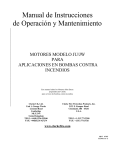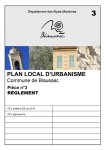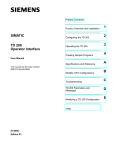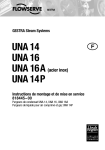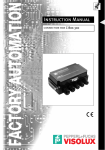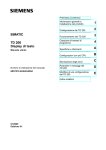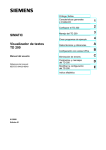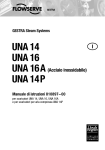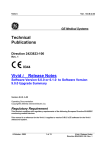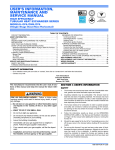Download Unitary products group WHOLE HOUSE DEHUMIDIFIER Specifications
Transcript
UNITARY PRODUCTS GROUP WHOLE HOUSE DEHUMIDIFIER Installation, Operating, and Maintenance Manual Installation, Operation, and Maintenance Instructions Contents Page 1. Safety .......................................................................... 2 a.Labeling ................................................................... 2 b.Instructions .............................................................. 2 2. Storage ....................................................................... 3 3. Specifications ............................................................. 3 4. Installing the Equipment ............................................. 3 a.Unit Location ........................................................... 3 b.Mounting .................................................................. 3 c.Condensate Drain ................................................... 4 d.Ducts ........................................................................ 4 5. Electrical ..................................................................... 4 a.Power Wiring ........................................................... 5 b.(Alternate) Remote Dehumidistat ............................ 5 c.Controls Connections .............................................. 6 d.Damper Connection ................................................ 7 6. Operation .................................................................... 8 a.General .................................................................... 8 b.Process .................................................................... 9 c.Sequence ................................................................ 9 i.Unit controls ........................................................... 9 ii. Wall control ........................................................ 10 iii. Frost control ...................................................... 10 d.Initial Set Up .......................................................... 10 7. Maintenance ............................................................. 11 a.Filter ....................................................................... 11 8. Wiring Diagram ......................................................... 11 9. Troubleshooting ........................................................ 12 10. Physical Dimensions .................................................12 SAFETY LABELING SAFETY INSTRUCTIONS DANGER!, WARNING! and CAUTION! WARNING! This dehumidifier must be installed by a qualified heating, ventilation, and air conditioning professional in compliance with all codes, local and national. Failure to comply with this WARNING! could result in severe personal injury or death. These words are used to identify levels of hazard seriousness as follows: DANGER! Signifies an immediate hazard which will result in severe personal injury or death. WARNING! Electrical shock hazard. Disconnect electrical power before starting installation. WARNING! signifies hazards or unsafe practices which could result in severe personal injury or death WARNING! Equipment must be grounded electrically in compliance with National Electric Code and local codes. CAUTION! Signifies hazards or unsafe practices which could result in minor personal injury or product and/or property damage. WARNING! Handle unit with care using adequate manpower or equipment to lift and avoid injury to personnel and/or equipment. CAUTION! Failure to install this dehumidifier in compliance with the instructions contained herein, could result in unsatisfactory operation and/or damage to the product. CAUTION! Unit must be installed in compliance with all codes. CAUTION! For proper operation, external static pressures across the unit must not exceed .6 in. w.c. 2 SPECIFICATIONS Capacity Unit Power Supply Minimum Circuit Ampacity Maximum Fuse Dimensions Weight Compressor Refrigerant Fan Motor Air Flow Filter Cabinet Insulation Duct Connection Drain Pan Pints per day @ 80°F DBT/60% RH Volts/Phase/Hz 13.1 15 amp Length (overall) Length (cabinet only) Width Height Pounds net Qty/Type Watts/RLA/LRA Qty/HP/FLA CFM @ .6 in. w.c. e.s.p. Type/size(in.) Type/thickness R Value Inlet/Outlet Material STORAGE 130 115/1/60 30.00 in. (includes duct collars) 24.00 in. 25.25 in. 20.50 in. 150 1/Rotary 1070/9.5/61 R22 1/0.1/1.15 400 Washable nylon/17x23.5 EPDM/1 in. 4.2 8 in. diameter duct Stainless steel Place the unit in a location that will allow a minimum of 22" clearance for filter removal and service access. This clearance is required on only one side of the unit since the filter is removable from either side. Allow adequate clearance to walls for normal unit service. Temporary storage must be indoors, upright in the original carton, and completely shielded from precipitation. CAUTION! INSTALLING THE EQUIPMENT Do not install the unit outdoors or in a location where it will be subjected to precipitation of any kind. UNIT LOCATION Unit location is very important as it will determine the overall length of the connection ducts. Locate the unit as close as possible to the indoor portion of the resident’s air conditioning unit or air handling unit, in the attic, basement, garage, or equipment room. The dehumidifier may be placed above, below or level with the air handing unit; however, removal of condensate must be considered when determining the location. MOUNTING The unit may be mounted on a flat surface or suspended. If mounted on a flat surface use the four rubber mounting feet provided. To minimize unwanted vibration select a level mounting surface. Adjust the four mounting feet to compensate for any irregularities in the surface. Ensure that the unit is sitting on all four feet. To suspend the unit a separate hanger kit (S1-DEHUHGKIT) is required. This kit consists of four brackets and four rubber isolators. Threaded rod or other means of suspension must be provided by the installing contractor and must be selected based on the unit weight, in compliance with local codes. If the unit is mounted above a ceiling or in an attic, a secondary drain pan under the entire unit is recommended. This pan should have a visible overflow drain that will alert the end user that a problem exists with dehumidifier’s primary drainage system. 3 be in compliance with local codes and be complete, tight, and leak free. Suspended unit utilizing optional hanging kit Ducts should be as short as possible, not to exceed 100 ft. equivalent length and supported in compliance with the manufacturer’s recommendation. CAUTION! All duct connections must be sealed. Any leakage in the duct work will adversely affect the operation of the dehumidifier and may lead to unsatisfactory performance. DAMPERS Optional dampers may be installed in the outlet duct, inlet duct, or in an outside air duct. These dampers must be full flow motorized type. Do not use any type of pressure operated damper as unacceptable pressure drop will affect unit operation. All dampers must be installed in compliance with the manufacturer’s recommendations and be insulated, and sealed per the section on ducts, above. CONDENSATE DRAIN ELECTRICAL The condensate drain must be trapped external to the unit. The trap dimensions must be equivalent to the dimension of the trap on the associated air conditioner air handling unit to prevent water being removed from the trap when the A/C unit is running. POWER WIRING WARNING! Turn off electrical power at the fuse or service panel before making any electrical connections. The ground connection must be completed before making line voltage connections. Failure to do so can result in electrical shock, severe personal injury or death. The dehumidifier must be installed so that the electrical components are protected from water from any source. A drain line must be attached to the trap outlet and pitched away from the unit a minimum of 1/8" per foot to allow the condensate to flow away from the unit. DUCTS The unit is furnished with two beaded 8" round collars for duct connections to the inlet and the outlet of the dehumidifier. These are located inside the unit and must be attached to the unit by the installer using screws and gasket or caulking. Center the collars over the inlet and outlet openings in the cabinet. WARNING! The cabinet must be permanently grounded. Connect the ground wire to the Ground terminal provided in the unit. Failure to ground the cabinet can result in fire, electrical shock, personal injury or death. Insulated flexible ducts in compliance with Underwriter’s Laboratory’s (UL) Standard for Factory Made Duct Materials, UL-18 and installed per the manufacturer’s recommendation should be used to connect the dehumidifier to the air conditioner. The installation and connections must The electrical supply requirements are listed on the unit rating plate and in the specification table above. 4 Use a separate fused branch electrical circuit containing a properly sized fuse or circuit breaker. Run this circuit directly from the main circuit box to an electrical disconnect which must be readily accessible and located within sight of the dehumidifier. Connect from the disconnect to the electrical connection within the dehumidifier utilizing the hole sized for 1/2" conduit provided on the entering air end of the unit. local building/electric codes, using copper conductors only. (ALTERNATE) REMOTE DEHUMIDISTAT The dehumidifier is supplied with its own, self contained, dehumidistat control which includes an air sampling sequence; however, the unit can also be controlled by a remote dehumidistat located in a conditioned space. DO NOT LOCATE THE DEHUMIDISTAT IN THE DUCTWORK. It is recommended that the remote dehumidistat, if used, be located in an area close to the air conditioner thermostat, out of drafts, away from heat sources, and out of direct sunlight. It should be located approximately 5 feet above the floor in an area with good air circulation at average temperature and relative humidity. WARNING! L (hot) and N (neutral) polarity must be observed when making the electrical connection to the unit. Installation of the electrical supply line must be in accordance with the National Electric Code, ANSI/ NFPA No. 70, latest edition, or Canadian Electrical Code Part 1-CSA Standard C22.1 and Remove the jumper on terminals S1 and S2 and connect the remote dehumidistat as shown on the unit connection diagram. INSTALLATION OPTIONS The dehumidifier can be connected so that the dehumidifier and the central air conditioner fan operate totally independent of each other (independent operation) or it can be connected in such a manner as to require that the dehumidifier and the central fan operate simultaneously (dependent operation). INDEPENDENT OPERATION Dehumidifier Connected for Independent Operation with Horizontal Air Handler/Furnace DUCT CONNECTIONS (Independent Operation) In this arrangement, the dehumidifier is connected across, or in parallel with the air conditioner air handler. The discharge of the dehumidifier is connected to the discharge of the air handler, and the inlet connection of the dehumidifier is connected to the inlet duct of the air handler. When the dehumidifier is connected for independent operation, the central air conditioner fan and the dehumidifier fan CANNOT operate simultaneously. • Dehumidifier installed in attic (sitting on floor or suspended from roof rafters • Piped parallel to air handler • Independent operation (furnace blower and dehumidifier do not operate at the same time) 5 • Turn off the air conditioner fan, during dehumidifier operation, if the FAN switch on room thermostat has been placed in the ON position for continuous operation Dehumidifier Connected for Independent Operation with Vertical Air Handler/Furnace Five wires run from the air handler/furnace to the dehumidifier to accomplish this interface, per Unit Connection Diagram (Independent Operation) and per the following: DEHUMIDIFIER • Connect the C, W, and Y terminals on the dehumidifier unit to the corresponding terminal on the air conditioner. Do not disconnect any of the existing wires from the C, W, or Y terminals on the air handler/ furnace. • Dehumidifier suspended from ceiling • Piped parallel to air handler • Disconnect the existing thermostat wire from the G terminal on the air handler/furnace. Using a wire nut, splice this wire to a new wire and then connect to the G1 terminal on the dehumidifier. • Independent operation (furnace blower and dehumidifier do not operate at the same time) CONTROLS CONNECTION (Independent Operation) • Connect the G2 terminal on the dehumidifier to the G terminal on the air handler/furnace. The dehumidifier controls must interface with the main air conditioning unit. This interface is required to do the following: All controls wiring, including connection to a remote dehumidistat, must be 18-22 gauge and must meet national and local electrical codes. Entry into the dehumidifier unit is through a 7/8" diameter hole located on the air entry end of the unit, adjacent to the unit mounted dehumidistat. Note that this is separate from the power entry. • Turn off the dehumidifier if the air conditioning unit is in the heating mode • Turn off the dehumidifier if the air conditioning unit is in the cooling mode Unit Connection Diagram (Independent Operation) MODEL NUMBER S1-DEHUMDKIT AIR HANDLER/FURNACE REMOVE JUMPER ON S1 & S2 WHEN OPTIONAL DEHUMIDISTAT IS USED WALL-MOUNTED DEHUMIDISTAT S1-DEHUSTAT (OPTIONAL) 6 these devices must be provided with a separate transformer, not from the transformer located in the dehumidifier. DAMPER CONNECTION If an optional damper(s) is used in the discharge/ return duct, this may be controlled by the dehumidifier. See Unit Connection Diagram (Independent Operation) for connection details. When connected as shown in the Unit Connection Diagram, the dehumidifier provides only the switching interface for the damper(s). Power for The damper control wiring must meet national and local electrical codes. Entry into the dehumidifier unit is through the control wire entry located on the air-entering end of the unit. Note that this is separate from the power entry. DEPENDENT OPERATION Connection Diagram (Dependent Operation) and per the following: DUCT CONNECTION (Dependent Operation) In this arrangement, the dehumidifier is connected either upstream or downstream of the air conditioner air handler. Both the discharge and the return of the dehumidifier are connected to the same side of the air handler. When the dehumidifier is connected for dependent operation, the central air conditioner fan and the dehumidifier fan MUST operate simultaneously. • Connect the D terminals on the dehumidifier unit to the R terminal on the air handler/ furnace. Do not disconnect any of the existing wires from the air conditioning unit. • Connect the DH terminal on the dehumidifier to the G terminal on the air handler/furnace. Do not disconnect any of the existing wires from the air conditioning unit. Dehumidifier Connected for Dependent Operation with Vertical Air Handler/Furnace All controls wiring, including connection to a remote dehumidistat, must be 18-22 gauge and must meet national and local electrical codes. Entry into the dehumidifier unit is through a 7/8" diameter hole located on the air entry end of the unit, adjacent to the unit mounted dehumidistat. Note that this is separate from the power entry. DAMPER CONNECTION (Dependent Operation) DEHUMIDIFIER Although not necessary, if an optional damper(s) is utilized in the discharge/return duct, this may be controlled by the dehumidifier. See Unit Connection Diagram (Dependent Operation) for connection details. When connected as shown in the Unit Connection Diagram, the dehumidifier provides the switching interface for the damper(s) as well as the line voltage power to the transformer (by others). Power for the damper(s) is provided by the dehumidifier. • Dehumidifier installed on floor • Piped return/return • Dependent operation (furnace blower and dehumidifier must operate at the same time) CONTROLS CONNECTION (Dependent Operation)—Illustration on page 8 The dehumidifier controls must interface with the main air conditioning unit. This interface is required to do the following: The damper control wiring must meet national and local electrical codes. Entry into the dehumidifier unit is through the control wire entry located on the air-entering end of the unit. Note that this is separate from the power entry. • Ensure that the air handler/furnace fan is on when the dehumidifier is operating Two wires run from the air conditioner to the dehumidifier to accomplish this interface, per Unit See Illustration on page 8 7 Unit Connection Diagram (Dependent Operation) S1-DEHUMDKIT REMOVE JUMPER ON S1 & S2 WHEN OPTIONAL DEHUMIDISTAT IS USED WALL-MOUNTED DEHUMIDISTAT (OPTIONAL) S1-DEHUSTAT OPERATION GENERAL in the space at comfortable levels; however, there are times during cool or rainy weather when the air conditioning does not operate often enough to keep the humidity at a comfortable level. Oftentimes, homeowners lower the thermostat to try to compensate for this and cause the air conditioning equipment to operate. Not only is this an expensive option, it may be counter productive. Cool air can hold less moisture and the relative humidity may increase. This accounts for the cool clammy feeling under these circumstances and, left alone, it will further promote mold and mildew growth when moisture condenses on cool surfaces. Relative humidity (RH) is defined as the amount of moisture in the air at a certain temperature compared to how much moisture it could hold if totally saturated. It is expressed as a percentage. Human beings are fairly sensitive to relative humidity as it affects the body’s natural ability to regulate temperature. As the relative humidity changes, so changes the rate at which evaporation of moisture on the skin occurs. This directly affects the body temperature regulating mechanisms. Under many conditions of comfort cooling or heating, the temperature of a conditioned space can be at a theoretically comfortable level while the relative humidity of the space is higher than would normally be acceptable. The results of this can be inadequate human comfort and moisture levels in the conditioned space that may promote mold and mildew growth. The whole house dehumidifier, on the other hand, operates when the regular air conditioning unit is not operating. When the dehumidistat senses that the humidity is high it starts the dehumidification process. The dehumidifier will remove moisture while NOT OVERCOOLING the space. As stated above, overcooling is expensive and does not do the job. When the humidity level is under control, the dehumidifier stops. Typically, operating an air conditioning unit during the cooling season will keep the relative humidity 8 discharge air temperature to be warmer than the entering air temperature. The amount of this temperature increase varies and is dependent upon the load (how much dehumidification is being done). In southern climates, often the heating and air conditioning equipment is turned off if the residence is to be unoccupied for an extended period of time. It is recommended that the dehumidifier be left ON even when the air conditioning is off. The internal fan in the dehumidifier will move air throughout the conditioned space to keep the humidity under control. Since the dehumidifier adds a small amount of heat to the space, it is recommended that the air conditioning and the dehumidifier be left on during unoccupied periods; however, the set point of the air conditioning unit should be set HIGHER than normal. The higher temperature will lower the relative humidity. This, coupled with the dehumidifier operation, will ensure a dry conditioned space. To ensure that the dehumidification process is maximized, a thermostatic expansion valve is used as part of the refrigeration system. This device provides exacting control of the system over a very wide range of operating temperatures. This is superior to lower cost refrigerant control devices such as capillary tubes which limit efficient operation to a very narrow band of operating temperatures. SEQUENCE Unit Controls PROCESS If no wall mounted dehumidistat is used, the unit will be controlled by the integral control system. This system operates the internal fan for 15 minutes approximately every hour to “sample” the air in the system. The air sample passes over the unit mounted humidity sensor. The unit mounted control should be set at approximately mid level. If the humidity level in the sampled air is greater than the set point, the compressor will be turned on, after a 3 minute delay. The fan and the compressor will operate until the humidity level of the air entering the dehumidifier satisfies the humidity sensor/setpoint. When the dehumidifier fan (blower) is operating, moist air from the conditioned space is drawn into the unit through the inlet duct. The air first passes through the filter in the unit. Once beyond the filter, the air passes through the cool evaporator (cooling) coil. This coil is part of the refrigeration process and is, therefore, cold. In all probability the coil is colder than the dew point of the air. Since it is below the dew point, moisture in the air will condense on the coil fins. Once condensed out of the circulating air, the moisture now in the form of droplets falls to the bottom of the coil and is collected in the drain pan. This is essentially the same process that causes water to drip from beneath an automobile when the air conditioning is operating. Wall Control When this control method is selected, the unit mounted control must be adjusted to its minimum (lowest relative humidity) level and never readjusted. The room dehumidistat should be set in the comfort area at approximately 50% RH (relative humidity). When the dehumidistat senses that the RH in the space is above its set point, an electrical contact within the dehumidistat closes causing the dehumidifier to start. The unit runs to dehumidify the air from the conditioned space until the dehumidistat is satisfied, that is, the RH has been lowered to the set point. Once the moisture has been removed from the air, it is somewhat cooler. However, since the air is cooler it cannot hold as much moisture and its relative humidity is high, even though moisture has been removed. To solve this “problem” the air next passes through a warm condenser (heating) coil where it is warmed. Since the air is warmed without adding any moisture, its relative humidity decreases sharply. This dry air is drawn through the fan and then expelled through the discharge duct back to the conditioned space. Dehumidifiers take latent heat (heat removed from water vapor when it condenses) and convert it to sensible heat (heat you can feel in the form of temperature increase). This exchange causes the Wall Mounted Dehumidistat 9 Frost Control Occasionally, frost will accumulate on the coil in the unit. This is not abnormal and may result from prolonged operation or if the conditioned space is relatively cool. If allowed to go unchecked, ice will eventually cover the coil, blocking air flow and interrupting proper operation of the unit. To prevent frost build-up beyond an acceptable level, a sensor mounted on the coil will stop compressor operation if the coil becomes unacceptably cold and remains there for at least 10 minutes. The fan will continue to operate to melt any accumulated ice. Once the ice has melted and the coil is warm, the compressor will restart and the dehumidification process will resume. INITIAL SET UP recommended that all adjustments be made in no more than 3% increments at no less than 24 hour intervals. Insure that power to the dehumidifier unit is turned on. For unit control, adjust the set point knob to approximately 60% RH. For wall control, adjust the unit mounted control to its minimum (lowest RH) setting and set the wall mounted dehumidistat to a desired level. It is recommended that it be set at approximately 60% at first and then adjusted no sooner than 24 hours later to a higher or lower set point as desired. It is Depending upon the conditions, the dehumidifier may operate for extended periods, especially when first started or after having been off. This is not abnormal and something for which the dehumidifier is designed. MAINTENANCE FILTER H The dehumidifier unit is equipped with a permanent nylon mesh air filter. This filter is washable and should be cleaned regularly, along with the air conditioner filter replacement. If it appears that the filter has become excessively dirty when cleaned at this interval, it may be necessary to adjust the cleaning schedule to more frequent cleaning. Excess dirt on the filter will reduce the air that can flow through it and reduce the overall effectiveness of the dehumidifier. Filter Replacement The unit Wiring Diagram is shown on page 11 and the Troubleshooting Guide is on page 12. 10 UNIT WIRING DIAGRAM 11 TROUBLESHOOTING PROBLEM Dehumidifier will not run Dehumidifier operates continuously but does not dehumidify Unit is noisy Water drips from unit Heat/AC unit is OFF, but dehumidifier runs POSSIBLE SOLUTION • Verify there is power to the unit • Check that any disconnect switch is ON • Check that the circuit breaker is not tripped (a separate 15 amp circuit breaker is recommended) • Verify the dehumidistat is not in the OFF position • Verify low voltage wiring between AC and dehumidifier is correct • Unit door switch is not mechanically actuated due to loose door. • Filter may be dirty. Clean filter • Dehumidistat set at unrealistically low setting. Reset to approximately 50% RH • Ensure unit is sitting level and on all four feet • Verify all panel screws are tight • Ensure unit is level • Verify condensate drain is properly trapped • Check for plugged condensate trap or condensate line • This is normal operation as long as there is power to the dehumidifier. Unit Dimensions All specifications and performance data subject to change without notice. 12 Whole House Dehumidifier Exploded View 13 Whole House Dehumidifier ITEM NUMBER Parts List DESCRIPTION QTY 1 7410 D114 DUCT, SUPPLY 1 2 7411 VB14 PANEL, BLOWER SUPPLY w/ INSULATION 1 3 7412 BM14 BASE, MOTOR 1 4 7413 MT14 MOTOR - 115V, 1/10 HP, 3 SPD 1 5 7414 BW14 BLOWER SET (WHEEL, HOUSING & INLET) 1 6 7415 RC14 CAPACITOR, (MOTOR) 1 7 7416 DP14 DRAIN PAN (STAINLESS) 1 8 7417 SM14 PANEL SIDE w/ INSULATION 1 9 7418 CO14 COI 1 10 7419 FT14 FILTER, 431x 595 x 5 mm, NYLON 1 11 7420 UF14 UPPER GROOVE, FILTER 1 12 7421 DR14 DUCT, RETURN 1 13 7422 TR14 TRANSFORMER, 115-24VAC, 24VA 1 14 7423 VR14 PANEL, RETURN AIR w/ INSULATION 1 15 7424 LF14 LOWER GROOVE FILTER 1 16 7425 SR14 SUPPORT, SIDE PANEL RETURN AIR 1 17 7426 TX14 TEX VALVE 1 18 7427 FD14 FILTER DRIER 1 19 7428 CS14 COMPRESSOR 1 20 7429 BT14 BOTTOM PAN 1 21 7430 SD14 PANEL, SIDE w/ INSULATION 1 22 7431 SP14 PANEL, FILTER w/ INSULATION 2 23 7432 PP14 PCB, MAIN 1 24 7433 HC14 SENSOR MODULE, HUMIDITY W/ HARNESS 1 25 7434 NC14 KNOB, CONTROL 1 26 7435 RI14 ISOLATOR, RUBBER 4 27 7436 AF14 FOOT, RUBBER, ADJUSTABLE 4 28 7437 DS14 SWITCH, DOOR 1 29 7438 CT14 PANEL, CONTROL 1 30, 31 7439 MH14 GROMMET, RUBBER, CLOSED, 7/8" OD 1 32 7440 RH14 POT, RH ADJUSTMENT, w/ HARNESS 1 33 7441 TP14 PANEL, TOP w/ INSULATION 1 34 7442 HG14 HANGER 4 35 7443 TS14 TERMINAL STRIP, TB-10, 5 AMP 1 36 7444 TS14-1 TERMINAL STRIP, TB-6, 30 AMP 1 37 7445 RC14-1 CAPACITOR, (COMPRESSOR) 1 38 7446 DF14 DEFROST SENSOR w/ HARNESS 1 14 LIMITED WARRANTY The model S1-DEHU130 dehumidifier, if properly registered by the return of the attached warranty registration to Unitary Products Group, is warranted to the consumer against defects in materials and workmanship for a period of five years from the date of installation, so long as the product has been installed and operated in accordance with all appropriate manuals and wiring diagrams. Any other defective parts will be repaired without charge except for removal, reinstallation and transportation costs. To obtain repair service under this limited warranty, the consumer must send the defective part to Unitary Products Group. THERE ARE NOT EXPRESS WARRANTIES COVERING THIS HUMIDIFIER OTHER THAN AS SET FORTH ABOVE. THE IMPLIED WARRANTIES OF MERCHANTABILITY AND FITNESS FOR A PARTICULAR PURPOSE ARE EXPRESSLY EXCLUDED. THE MANUFACTURER ASSUMES NO LIABILITY IN CONNECTION WITH THE INSTALLATION OR USE OF THIS PRODUCT, EXCEPT AS STATED IN THE LIMITED WARRANTY. THE MANUFACTURER WILL IN NO EVENT BE LIABLE FOR INCIDENTAL OR CONSEQUENTIAL DAMAGES. This limited warranty gives you specific legal rights, and you may also have other rights which vary from state to state. Some states do not allow either limitations on implied warranties, or exclusions from incidental or consequential damages, so the above exclusion and limitation may not apply to you. Any questions pertaining to this limited warranty should be addressed to Unitary Products Group. The Unitary Products Group has elected not to make available the informal dispute settlement mechanism which is specified in the Magnuson-Moss Warranty Act. Unitary Products Group 5005 York Drive Norman OK, 73069 www.source1parts.com Tel. 1-800-536-6112 15 WARRANTY REGISTRATION Enregistrement de la garantie MODEL S1-DEHU130 MODÈLE S1-DEHU130 OWNER'S NAME Nom du propriétaire: STREET ADDRESS Adresse: CITY Ville: DEALER'S NAME Nom du marchand: STREET ADDRESS Adresse: CITY Ville: DATE OF INSTALLATION DATE DE INSTALLATION STATE Province: POSTAL CODE Code postal: STATE Province: POSTAL CODE Code postal: SERIAL NUMBER NUMÉRO DE SÉRIE Design, material, performance data and components subject to change without notice. UNITARY PRODUCTS GROUP 5005 YORK DRIVE NORMAN OK, 73069 12/14/06 Rev. A FORM# 16007
















